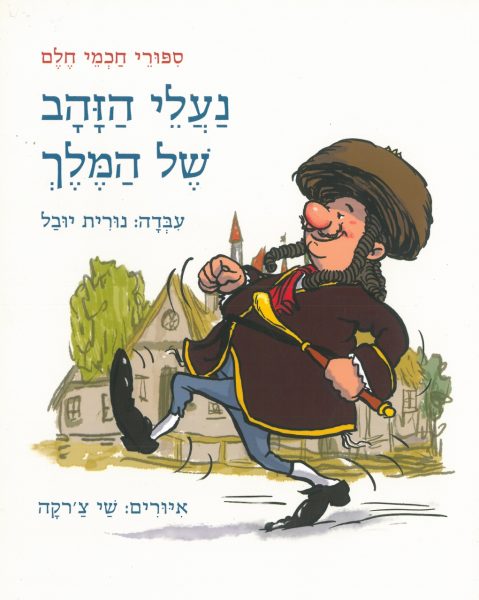מימי לוי, הגננת של גן תמר בשוהם בשיתוף עם פאני הסייעת, גבריאלה הגננת המשלימה וילדי הגן הכינו "חנות נעליים" בעקבות הסיפור "נעלי הזהב של המלך".
גם הוריהם של ילדי הגן היו שותפים ליוזמה המבורכת ודאגו לשלוח לגן נעליים וקופסאות נעליים.
הילדים תמחרו את הנעליים על-פי קריטריונים שנקבעו בקבוצה, סידרו את החנות והחליטו על כללים להתנהלות תקינה.
הפעילות היתה חווייתית, משמעותית ומלמדת עבור הילדים וגם עבור צוות הגן.
הילדים וההורים נהנו מהפעילות המתמשכת שנגעה בתחומי דעת שונים כגון: תכנון, איסוף, מיון, בחירות דמוקרטיות, בניית כללים, סידור וארגון.
צוות ספריית פיג'מה מודה למפקחת אהובה, למימי הגננת, לצוות הגן, לילדים ולהוריהם על ששיתפו אותנו בחוויה המיוחדת והמקסימה.




בגן סלעית בבאר שבע של הגננת מירי ארדסטי כל ילד הכין זוג נעלים המתאים למלך.
ורדה אבוטבול גננת גן פשוש בטבריה לימדה את הילדים אוצר מילים של חכמת חלם, המחיזה את ההצגה ושוחחה עם הילדים על ההשלכות בחיי היום יום.
ילדי גן אופק ברמלה והגננת דנה דרייפוס יצרו נעליים מחומרים שונים והציגו את התוצרים בתערוכה
עליזה כהן גננת גן כרמלית בחולון שוחחה עם הילדים על חשיבות כבוד האדם ועל כך שאנשים נמדדים על פי מעשיהם ולא על פי רכושם וממונם.
כתבה לנו מעין כתר גננת גן תות בקיבוץ ברור חיל: תוך כדי קריאת הספר שוחחנו על המושגים המופיעים בו - כבוד, חלם וכו'. עצרנו באמע הקריאה והילדים שמשו ''חכמי חלם'' ויעצו עצות שונות. בתום הקריאה הבאתי חתיכת בד וכל ילד השתמש בה באופן שהפך אותו למלך לרגע ושאר הילדים כיבדו אותו בקידה.
הגננת נעמה עזרא מגן עירית ברחובות שוחחה עם הילדים על מאפיינים של בעלי מקצוע והזמינה את אחד האבות בגן שהוא איש צבא קבע לספר על עבודתו, על המדים שהם הבגדים הייצוגיים שלו ועל הסמלים שעל המדים.
הגננת ענת אלחנאתי מגן לילך באריאל מציעה משחקים סביב מוטיב הנעליים: הילדים יושבים במעגל וכל הנעלים בערמה במרכז המעגל. לסימן מוסכם כל ילד מוצא את זוג הנעליים שלו ונועל במהירות. משחק נוסף: הנחתי על הרצפה כל מיני סוגי נעליים ( נעלי בית, נעלי עבודה, נעלי יציאה, נעלי בלט, כפכפים, סנדלים, מגפיים, נעלי צבא). אחד הילדים היה צריך לתאר נעל והילדים צריכים לנחש באיזו נעל מדובר. במשחק השלישי משתמשים בסוגי הנעליים מהמשחק השני וכל ילד בתורו עושה פנטומימה של פעולה והילדים מנחשים איזה נעליים מתאימות לפעולה (למשל תנועות ריקוד מתאימות לנעלי בלט או לנעלי ריקוד). כמו כן נערכה שיחה על חלקי הנעל, על החשיבות של נעליים וסיפרנו בגן סיפורים שעוסקים בנעליים כמו סינדרלה, הסנדלר והגמדים ועוד.
בגן תמר בקיבוץ משגב יצרו הילדים, עם הגננת ליאורה נגרין, נעליים מסוגננות מנעליים ישנות
.אתי לוגסי גננת גן חמנית בקריית ים לימדה בגן את ערך הצניעות וערך שווה בין שווים.
בגן שיבולת במיתר של הגננת שירה סופר יצרו פינת חכמי חלם בה ילדים פתרו בעיות על ידי מתן עצות משעשעות ויעילות.
תודה למיכל זמיר, ששלחה לנו תמונות מאירוע להורים וילדים בברלין, גרמניה סביב הסיפור "נעלי הזהב של המלך".
מיכל כתבה:
"היום מספרת הסיפורים שלנו יפעת מאור סיפרה את הסיפור 'נעלי הזהב של המלך'. דיברנו על ההבדל בין עטיפה ותוכן,
בין הקנקן ותוכו. המחשנו זאת בעזרת קופסא מוזהבת מלאה אבנים פשוטות לעומת קופסת עץ פשוטה מלאה בעוגיות וניל
טעימות וריחניות שאפינו. דיברנו גם על כבוד ועל איך משיגים אותו, והמשכנו עם שעת יצירה בה יצרנו כתר מוזהב מעוטר
 באבנים יפות. רוב תודות!"
באבנים יפות. רוב תודות!"










 באבנים יפות. רוב תודות!"
באבנים יפות. רוב תודות!"